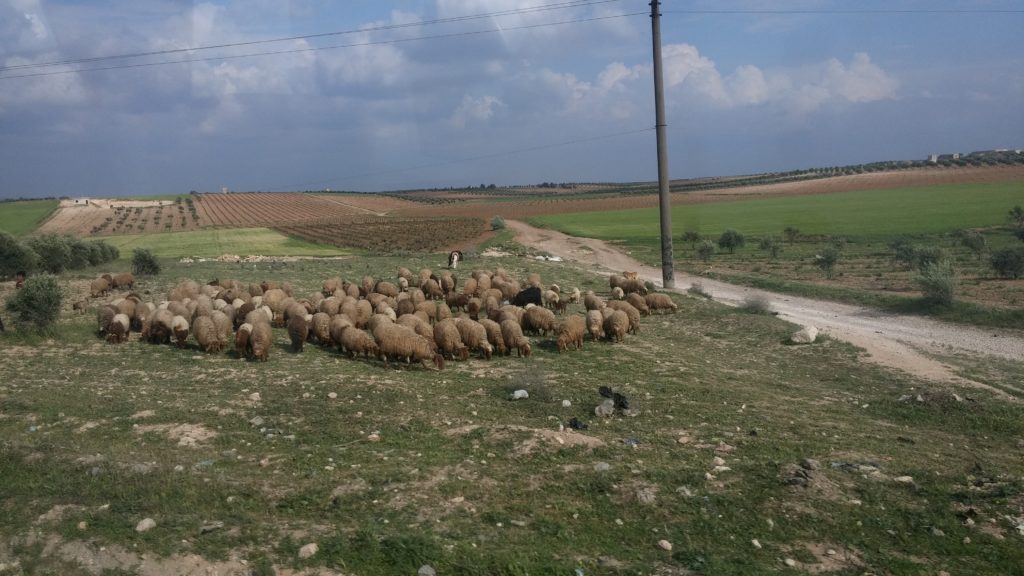An American Housewife in Syria – Part 3: On the Road to Homs
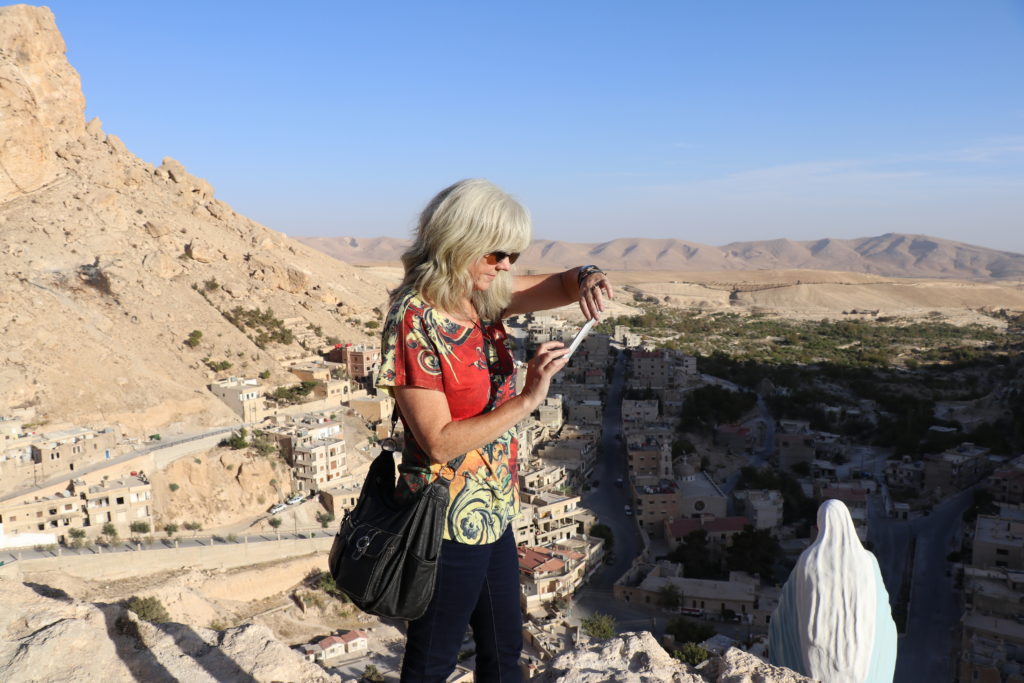
By: Janice Kortkamp
Date: July 15, 2018
An American Housewife in Syria – Part 3: On the Road to Homs
I love Damascus but as much as I enjoy spending time in that great city, getting out on the road in Syria is even better – and crucial to understanding both the country and the conflict. We won’t even get to Homs yet though, in the present installment of this series on my travels in Syria, but will focus instead on an extraordinary place between the capital and Homs, Ma’aloula, as well as being on the road itself.
One of my favorite topographical sights is what I think of as the Spine of Syria. A long exposed rock ridge feature that parallels much of the road that is itself the backbone of the country – the route from Damascus, through Homs and to Aleppo, going south to north through the three largest cities. Each of these cities has its own predominant character in my mind – as do towns and villages: Damascus the elegant cosmopolitan capital; Homs the earthy boisterous hub of the country; and Aleppo the stately, dignified industrial heart. Of the three, Damascus has suffered the least damage though still significant, while half of Homs and at least a third of Aleppo are utterly destroyed. But it is the Syrian people themselves who are the core, the spine, if you will, that has remained resolute often out of sheer necessity to survive and, as former MI6 officer and senior level British diplomat Alastair Crooke stated, “Steel has entered into the Syrian soul.” Whether that steel is new is debatable in my opinion, perhaps it was a broken blade, one that has been re-forged in the fires of this crisis, or I believe, just one that had been resting on a shelf for a while. I’ll never forget one trip on that road, coming back to Damascus from Homs, tired and melancholy. The sun was setting in one of the car’s windows and the moon was rising in another punctuating the purplish vast sky, ‘the Spine’ gently lit on my right, while Pink Floyd’s Breathe provided the perfect soundtrack to the surrealistic experience:
“Breathe, breathe in the air; don’t be afraid to care.
Leave but don’t leave me.
Look around and choose your own ground.”
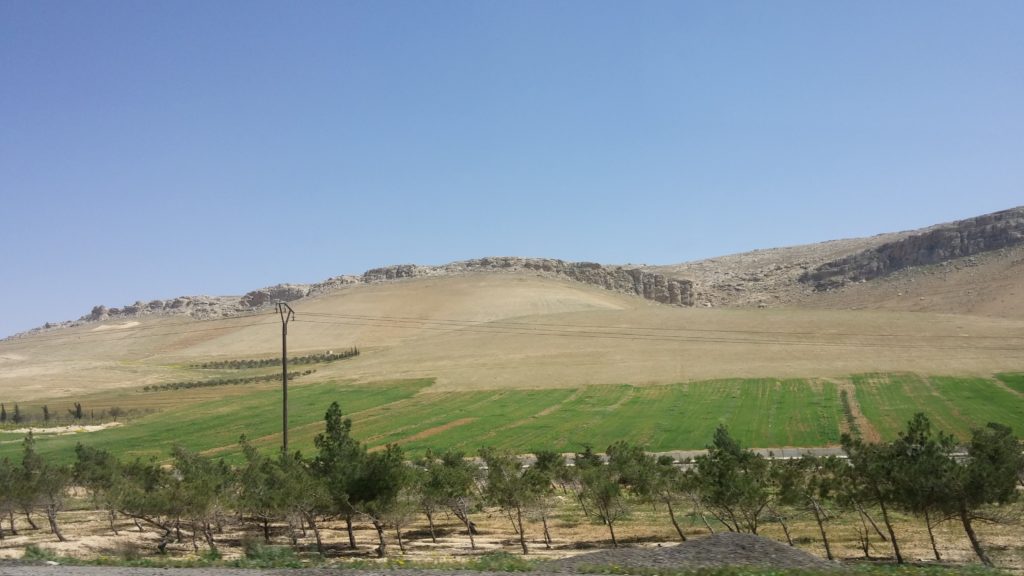
An interaction that changed me forever and put some steel in my soul occurred on my first trip, heading out of Damascus towards Ma’aloula. At that time, in May of 2016, security around Damascus was much more omnipresent than it is now. Military checkpoints were everywhere and at each one papers for the rare foreigner like myself were checked and every car looked over for carrying weapons or bombs, etc. (There were still several checkpoints on my last trip in April of 2018 but fewer in number since the recent liberation of the city from all terrorist “rebel” groups that had it almost completely surrounded at one point.) Outside the city on the road to Homs was a major checkpoint where my friend (who was acting as my translator and guide) and I had to pull over and show the travel permissions paperwork to the commanding Colonel there. We also had to arrange for military escort to Ma’aloula as it is an active military zone. My friend carried the papers into the bunker while I remained in the car. A few moments later, the Colonel himself came over and motioned me to get out of the vehicle. I knew that an American woman traveling around Syria as a tourist-researcher was unheard of at that time so I was glad to meet him and eager for him to see that my intentions were good willed and supportive. The man had a weathered face and the brightest blue eyes and he looked into mine intently as he reached out for my hand to shake it – and then he held onto it, thanking me profusely for coming to Syria to see for myself what was happening there. He invited me into the bunker for some coffee and a cigarette where he shared about his love for the army and what this fight meant to Syria. Again and again he thanked me for coming and he asked me in a most gentle but impassioned way to share what I learned back home in America. I assured him that was the reason I was there. My friend and I had a similar visit with him on another journey that trip. On that visit, there were several soldiers also in the bunker. Some of the soldiers had been involved in the battles for Ma’aloula (which I’ll describe later in this article) and one had been wounded there when the US sponsored Free Syrian Army fighting alongside al Nusra (which is al Qaeda in Syria) bombed the army checkpoint outside that village. He showed me the scar on his leg. They were all respectful, friendly, and interested in what I was doing coming to Syria during the war.
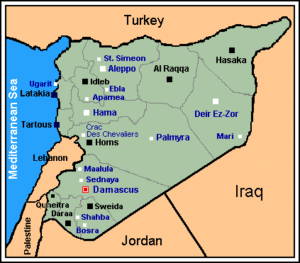
I’ve never seen the Colonel or his men again since that first trip because about a month after I got back home I learned that they had all been killed by a hand grenade thrown into the very bunker where we had shared those times together. Knowing them and their sacrifice added a certain strength to my character that hadn’t been there before. Never afterwards have I had serious concern about what people say – criticisms, attacks, slanderous false accusations, or awkward silences when friends or neighbors can’t understand what I’m saying or refuse to believe it. It’s not that it doesn’t hurt – it does – it’s just that it does not compare with what the Syrian people have been through or my own personal commitment to share what I’ve learned.
After the violence began in 2011 a strange phenomenon manifested. The great majority of the Syrian people, people from all the family groups, religions, areas of the country etc., that did not join in the “revolution” were made inconsequential – utterly ignored, dismissed by western media and of course the western governments shouting for “regime change”. Never did people in America or Europe hear from this vast group that rallied around their country’s flag, their army and their president as most anyone in America or elsewhere would have done in similar circumstances. Support always entails a spectrum and support for President Assad ranges from total devotion and love to resigned acceptance that the status quo is dramatically better than anything under the so-called “freedom fighters” sponsored, armed, trained, funded, and recruited for by the US and its allies. The simple reality is that at no time since the beginning of the conflict has anyone living under “rebel” control had any greater freedoms than people living under government control; in fact the opposite is true, they’ve had significantly fewer freedoms as the areas falling to the “rebels” were all put under harsh sharia law that was instigated and maintained by violence and intimidation. In the New York Times from March 2013, Neil MacFarquhar described this dark side of the revolution in his “A Battle for Syria, One Court at a Time” , the term court meaning sharia court noting,
“The group found that in many cases, fighters lacking training in Shariah, or Islamic law, not to mention civil law, handed down death sentences to government supporters with little or no defense. Commanders of the more secular Free Syrian Army were not much better, the group discovered.”
The clarion shout of the US backed “moderates” and acknowledged extremists alike was often, “Alawites to the grave, Christians to Lebanon.” Religious and ethnic cleansing of Syria was being implemented by the armed groups at an alarming rate and women under “rebel” control found their status in society reduced to one more typical of Saudi Arabia than Syria. While women are a part of every aspect and every level of society in government controlled areas (and wear what they wish without any government dictates on clothing), in the “rebel-liberated” zones celebrated as victories by the US and other western governments, women and girls experienced the “freedom” to get bought and sold as temporary wives to militants (a practice known as “sex jihad”), also the freedom to be raped, kidnapped, tortured, or killed which before 2011 were unheard of crimes.
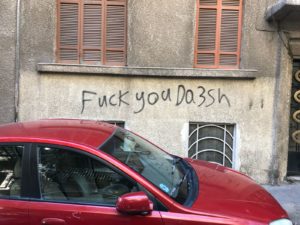
So the many millions of Syrians, including most of the Sunni majority, who support the secular, civilized nature of Syria, who appreciate having freedom of religion, freedom for women, freedom to have a drink in a bar, freedom of education for girls and boys that’s not just religious indoctrination for extremism, and for some, particularly religious minorities, the “freedom” to exist at all were either treated in western media if mentioned at all as either poor suffering victims “too terrified of the regime” to speak out against the government or join the revolution; or “Assad apologists”, stooges, foolishly following a “brutal dictator” who loved nothing better than to gas or bomb innocent civilians, particularly women, children, hospitals, cats, gardeners, and clowns.
Father Daniel Maes, a Flemish priest who lives in a monastery in Syria that was for years surrounded by terrorist groups said,
“Do you think that the Syrian people are stupid? Do you think those people were forced to cheer for Assad and Putin? Do you not know that the media coverage on Syria is the biggest media lie of our time? They have sold pure nonsense about Assad: It was actually the rebels who plundered and killed. It is the Americans who have a hand in all of this, for pipelines and natural resources in this region and to thwart Putin. Saudi Arabia and Qatar want to establish a Sunni state in Syria, without religious freedom. Therefore, Assad must go. You know, when the Syrian army was preparing for the battle in Aleppo, Muslim soldiers came to me to be blessed. Between ordinary Muslims and Christians, there is no problem. It is those radical Islamic, Western-backed rebels who want to massacre us.”
As I’ve mentioned in a previous article in this series, Syrians have full and open access to the internet and many speak English. They’ve seen and heard what western media outlets have been touting – and they’re disgusted by the almost total lack of unbiased reports. In Syria people often say, as one shopkeeper in Damascus told me, “Please, tell the people in America what is really happening here. If you see something bad, say that. If you see something good, say that.”
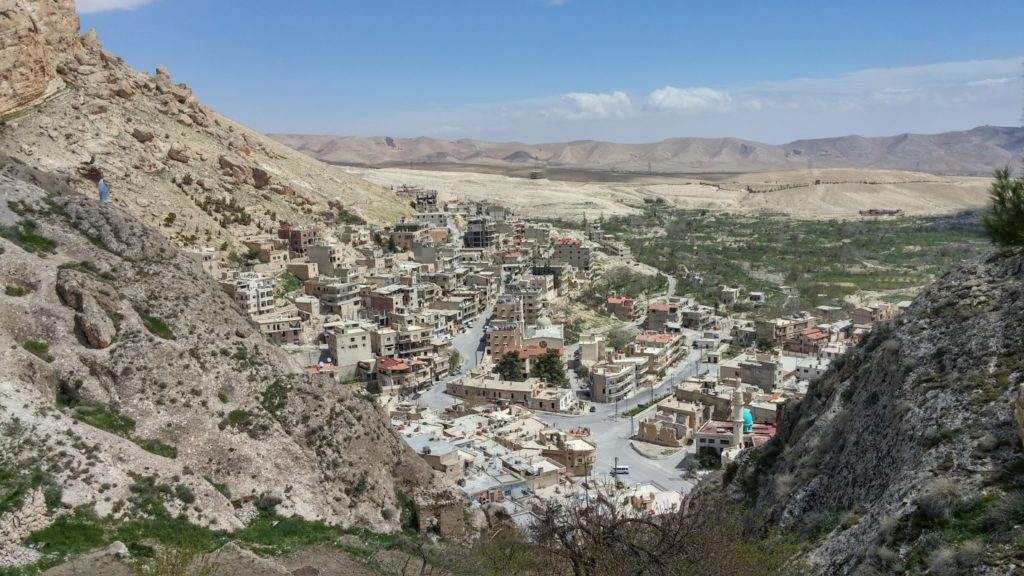
So, to return to the story from May 2016, after meeting with the Colonel and getting our military escort, it was back on the road to Ma’aloula with our new friend, a lieutenant who had been a doctor before the war, in our car and some other soldiers in another vehicle – and we made our way to the famed, ancient Christian village enclave of Ma’aloula.
Several years ago, I was on the phone with a Syrian soldier who fought in the battles to retake Ma’aloula from the Free Syrian Army and al Nusra (al Qaeda in Syria) combined force that had captured it. Though not a Christian he described the feeling he had entering the valley, “Jan, there was such a sense of peace that came up from the ground, through my boots and up my legs through my body. I told my men (he was a captain) to not fire any bullet they were not absolutely sure of – to not do any unnecessary damage.”
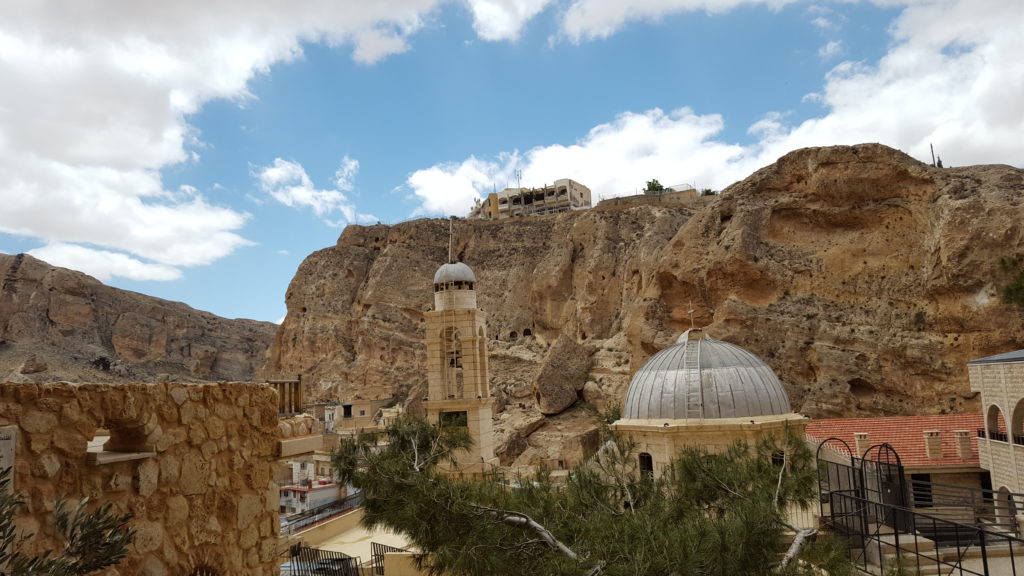
Ma’aloula has always been a special place to most Syrians; before the war it received around 200,000 visitors a year, both Muslim and Christian Syrians as well as foreign tourists. Since the first generation of Christians (Syria was also the first official Christian nation on earth), throughout most of history, Syria has been a Christian sanctuary. Ma’aloula is one of few places in the world where Aramaic, the lingua franca during the time of Jesus and ages before, is still spoken, and church liturgies are conducted in a mix of Aramaic and Arabic. The name “Ma’aloula” is an Aramaic word that means “entrance”.
The peace of the place came under attack in the fall of 2013 when the US-backed Free Syrian Army joined with al Nusra (as has often happened throughout the war) and together they stormed in by first bombing the army checkpoint then falling on the village like barbarians from ancient tales though in pickup trucks with mounted big guns and brandishing AK47s. They quickly took control over much of the village and rounded up civilians whom they forced to either convert to what they refer to as “Islam” or get executed. Many civilians were killed; however thanks to the efforts of the local militia men and Hezbollah fighters who held off the armed militants for a few days from taking over the entire area, most civilians were able to escape using drainage tunnels. The militants burned and destroyed many homes, businesses, and churches including the local orphanage. Al Nusra fighters kidnapped the nuns of the orphanage and held them for ransom. Valuable antique icons and manuscripts were damaged or looted.
The terrorists held Ma’aloula for almost two years before the Syrian Army recaptured it in the spring of 2015, and a year later I got to go for the first time after reading about it for years. Since May of 2016, I’ve been twice more.
The feeling of peace my soldier friend described is still there – it’s a place that made me want to linger, wander around on the rocks, and have tea and a picnic in spite of the destruction. Lingering is still a luxury though in places like Ma’aloula during the war and going there now necessitates using the time to focus and learn as much as possible before too late in the day due to the necessity of getting back to Damascus before nightfall (two years ago traveling on the road at night wasn’t the best idea).
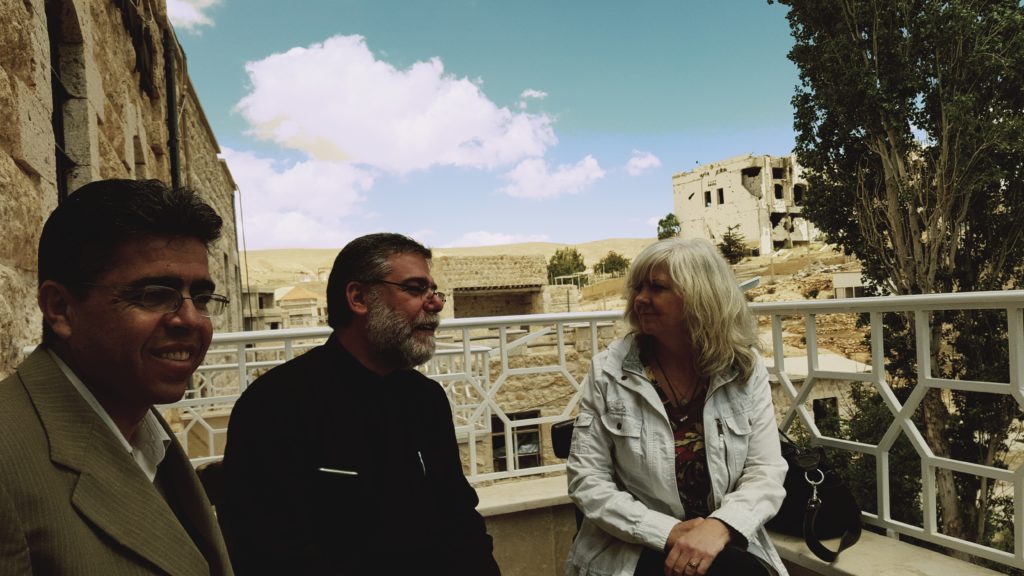
The stories from Ma’aloula are harrowing as are those you hear all around the country. I met Mayor Youssef Saadi and Father Toufic Eid,the parish priest at the time of the Saint Sergius Greek Catholic Monastery, some parts of which date to the 400s AD and named after a martyred Roman soldier. The mayor’s young son was killed in Damascus by a terrorist “rebel” mortar. Father Toufic was laboring to rebuild the village and church after the destruction – not just buildings but rebuilding people too, from all the sorrow as they began to return to their homes. I appreciated when Father Toufic mentioned that the emphasis of rebuilding was on houses first, then churches. Yet in true Syrian-hospitality fashion these two gentlemen who had lived through so much invited me for tea and cookies homemade by the mayor’s wife.
The events in Ma’aloula are already legendary in Syria as they also should be outside Syria if commonly told history ever accurately portrays what happened there. Eva Bartlett’s report on the battles and situation is my favorite, highly descriptive and informative and sharing the personal memories of people I know there. Please read her article, Overcoming Savagery and Treachery, Maaloula’s Heroic Defenders Fight for the Future.
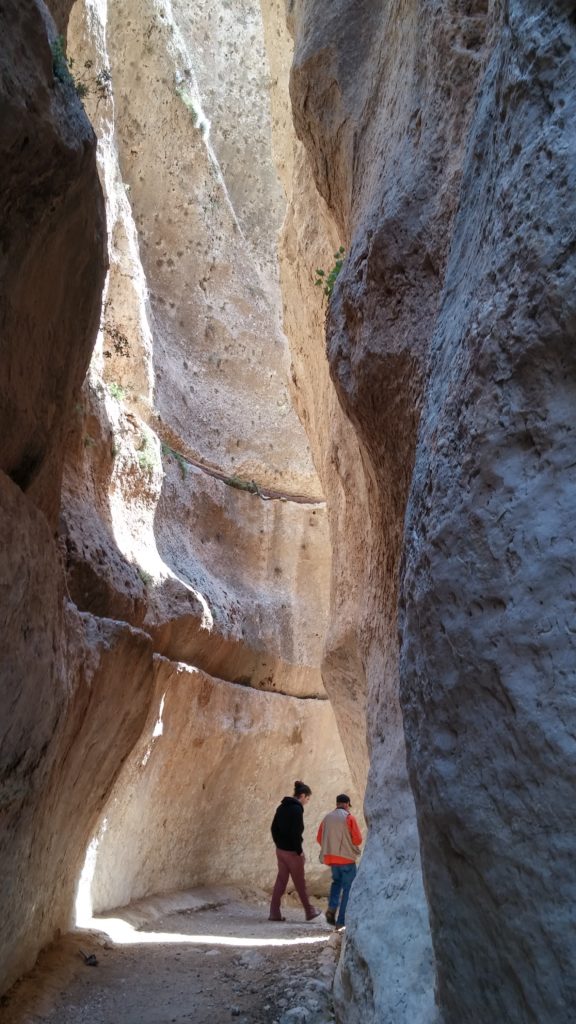
The foot path from the main part of town to the St. Thecla Convent is one of the greatest walks in Syria, a serpentine trail through the fabled cleft in the rock that opens in the middle to a large area of high cliffs with hewn niches for tombs; how I would love to camp there for a night and just let those rocks tell their stories. One version of The Legend of Saint Thecla and the cleft that forms the path is from Roman times, when the young woman Thecla, reported to be a pupil of the Apostle Paul, was being pursued by soldiers commanded by her father to arrest her for her Christian faith. Her escape was blocked by the mountains but after she prayed for deliverance, the mountains split to open the way. I like legends, and so I imagine a young girl getting miraculous help whenever I walk that path and because I always wear sandals wandering around Ma’aloula – I let the dust of that path linger on my feet. It is a particularly poignant story given the recent history because the saving of the town and most of its civilians from the terrorist groups is an epic tale in itself.
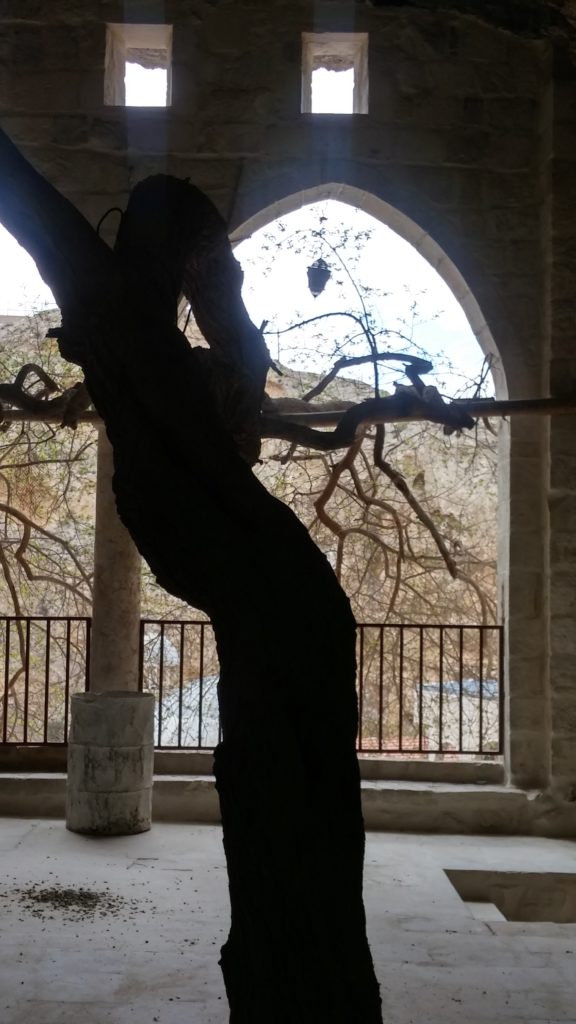
On the far end of the trail is the convent and orphanage named for that young lady, who is said to have spent the rest of her 90 years in the grotto that is the site of the current convent, and the sweet spring she dug is famed for curing illnesses and infertility – Christians and Muslims alike are pilgrims there in hopes of healing or the blessing of children.
Sadness of course pervades and seeing the destruction, the charred remains of fires, the broken and empty play equipment for
children, and the worn, bent back of the priest there is sobering … and infuriating. These are the same emotions that strike everywhere I visit in Syria: reality sucks and war is truly hell – a demons’ holiday.
In the courtyard is an ancient apricot tree, a “White Tree of Gondor” kind of symbol if you’re familiar with Tolkien’s Lord of the Rings and I was delighted and encouraged to see that the tree had foliage. Of course I also tasted the spring waters though I had no immediate need of miraculous cures and am not looking to be fertile at this point in my life! My prayers instead were for the healing of Syria itself. Thankfully on my last visit, quite a bit of reconstruction has already occurred, in Ma’aloula and in many areas around the country.
Leaving Ma’aloula behind and getting back on the road north towards Homs is another fascinating stretch as the desert-like scenery eventually gives way to farm fields and sheep pasturing amid the now-familiar bent trees on the often windy stretch. Homs is our destination for the next in this series, a city with two sides like the moon: one dark – horrifically scarred by ruins of war; and the other light – energetically proceeding with life and restoration. Hope you’ll join me.
“For long you live and high you fly, and smiles you’ll give and tears you’ll cry.
And all you touch and all you see,
is all your life will ever be.”
(Breathe by Pink Floyd – thanks Roger Waters)
